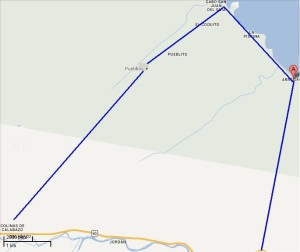Tonight, I was robbed by two muchachos in the streets of Tumbaco. It was a short encounter with the brute directness of imposition, the rapid crossing of foreign life lines, the intrusion of characters in my life not chosen to meet deliberately.
I was out for dinner with Lili: we had delicious Tortillas de Papa and humitas, bags of corn, in a traditional restaurant, later two beers and the time passed rapidly with kind chatting about life and future. At about eleven p.m. we walked down a lonely street near the central parque to fetch a cab when behind a passing car two youngsters in hoodie jackets crossed the road to our side. Lili, with an accurate intuition instantly suspicious, began to run while I, just not believing that something like that could ever happen, continued steadily. The first guy stopped me while the other approached me from behind. After a short struggle and a little conversation (que quieren?, que quieren?), they got away with a five dollar note of my wallet. A cheap but important lesson: when in doubt, better run.
Quito
In our two visits, Quito showed us its two faces: the old part in the south, densely peppered with churches from baroque and colonial era, with hilly streets of copple and generous parks and places. And the new part of the city, high-rise buildings of the 70’ies, american hostels in gringolandia and stretched out highways. Quito is beautifully placed on a mountain platform at 2800m with buildings on the ridge to the valley, it is the second highest capital of the world and the only highlands along the ecuator.
The museum of ecuatorian culture impressed us with the highly advanced manufacturing techniques of gold and copper, and together with Carolina from Tabacundo, who spent a few days working in the city, we enjoyed the Capilla del Hombre of the national artist Guayasamín, a haunting memorial for the suffering of mankind. We were honored with the opportunity to visit the governmental palace but did not meet Correa this time. Nevertheless we had a nice discussion about Moreno, one of the most controversial presidents and womanizers in ecuatorian history.
In the bus backwards, passing on a steep road the ancient suburb Guápulo, I met Lili, a merry and pretty girl, who invited me to a hike on a nearby mountain: together with her brother Thomas and his girlfriend Susana we passed a jaunty leisure time on the heights of Quito.
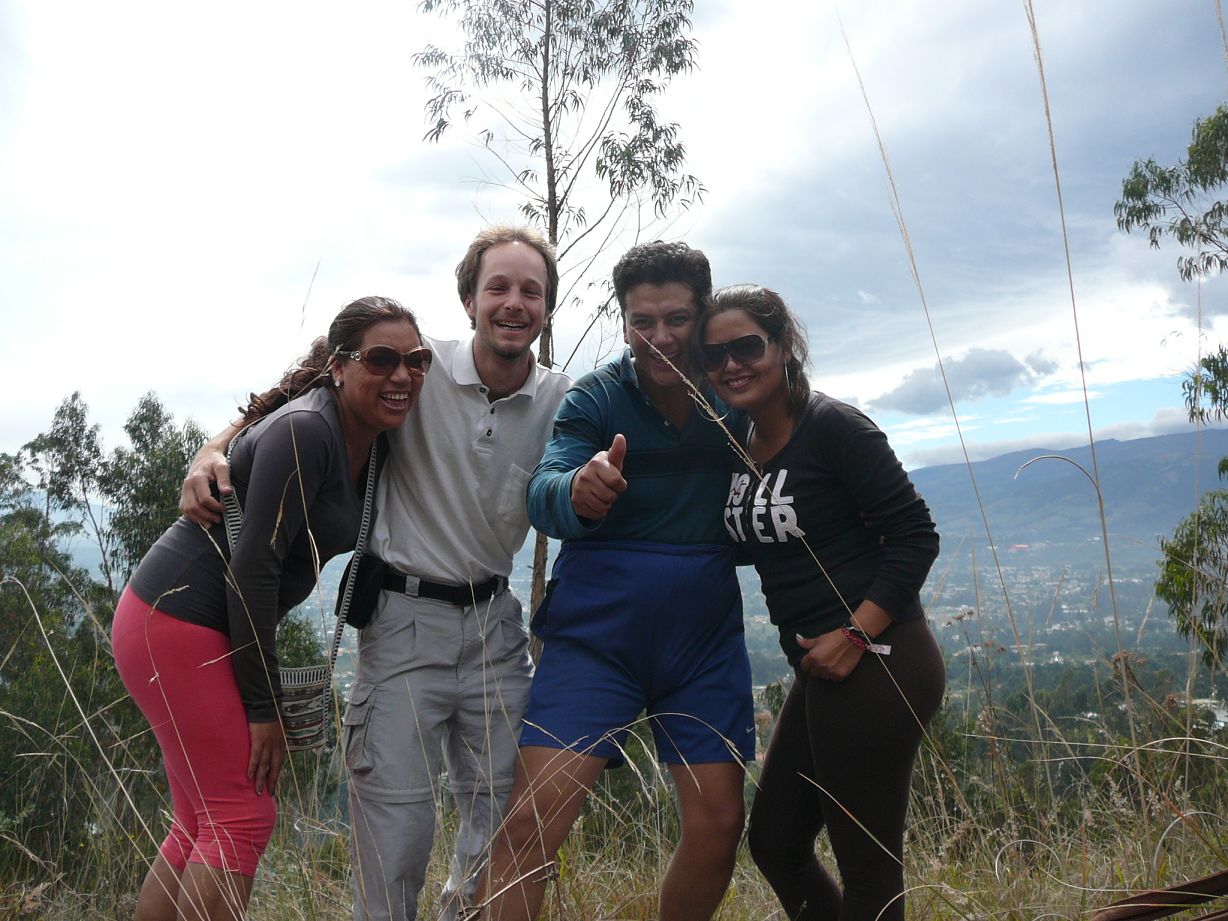
Dancer in the dark
Sometimes, it happens that you just feel in the right place at the right time. We’ve barely built up our tents in the frontyard of a ranch we’ve found along the road when the kind family invited us to the fiesta de San Pedro in Tabacundo. The whole village was on its feet: the man in the clothing of Aruchicos, the women in beautifully woven skirts, and even the children dressed up in traditional midget costumes. The men playing instruments and singing, the women dancing, and, at times, in front of a group passing by, el diablo, cracking the whip. It was only a limited range of songs and melodies, but, in the endless loop, the music captured the bodies and made them the figural and will-less expression of its rhythms. Hovering skirts, swaying hips and stamping feet. You don’t feel lonely in the crowd, what is personality, what is our specific individuality, but you feel closer to the stream of life, just watching, just listening, just moving.
The fiesta lasted for the whole night and the other day.
In the afternoon, together with Carolina, we had the chance to take a ride on some horses of the ranch, for me the first time after about 20 years: it’s not just another means of transport! A horse has his own will and the covered distance is a compromise of your demands and its courtesy.
German, the owner of the Ranch G, a man full of energy and life, last man standing after a long night with Chicha, his own caña liquor, lighted a hellfire to warm us up by the fireside and the night passed rapidly with stories of his hitch-hiker time in Europe. After a hangover breakfast we bid a cordial farewell from this amicable family and hit the road again heading through desert land to Quito.
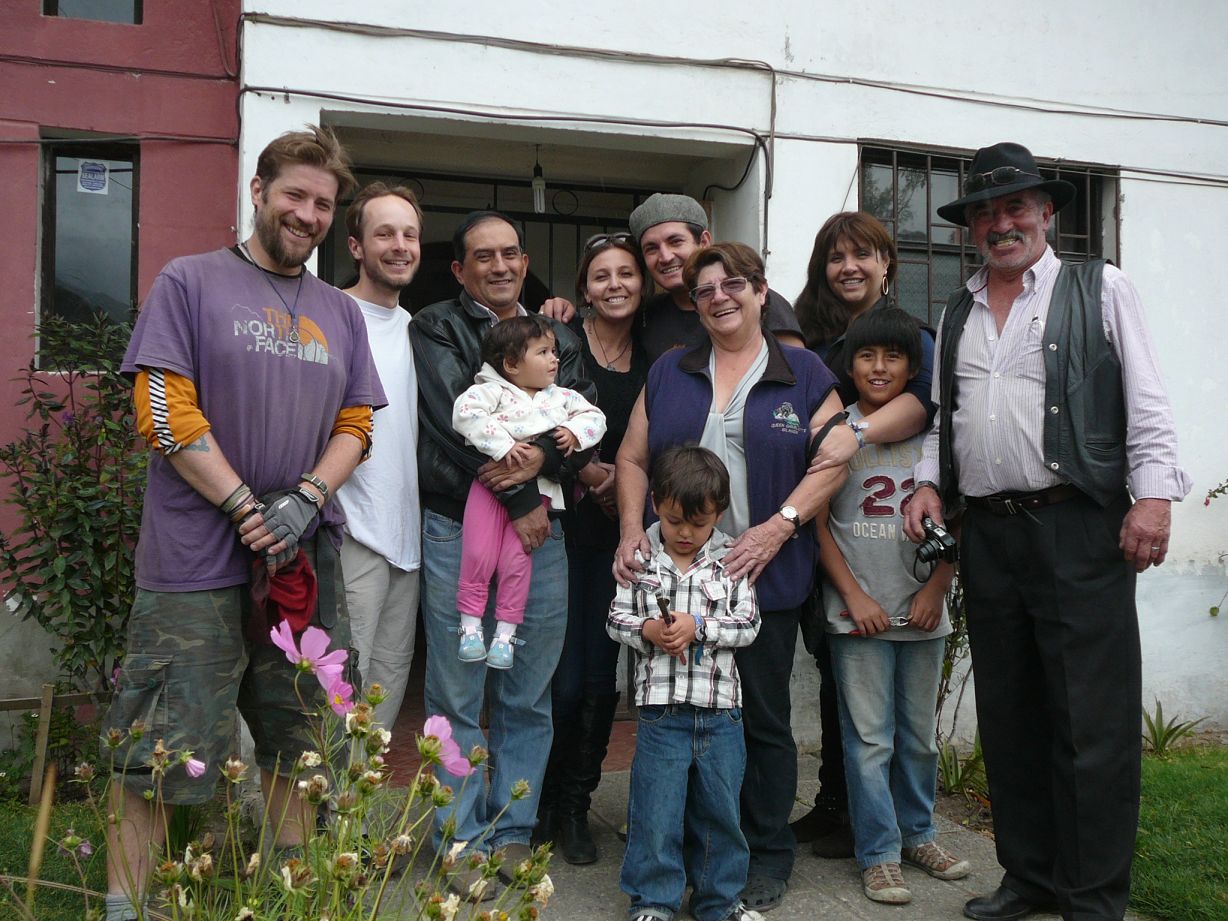
In the Cotacachi Cayapas Ecological Reserve
Otavalo is mainly known for its Poncho market and the business acumen of its habitants. Since a cycling traveller might take along only memories, we rather planned to ascent the near vulcano Cotacachi (4935m) spending one night in the tents. Looking desperately for hiking boots in the whole village, I could find only shoes up to size 40. I finally squeezed my size 42-feet into one pair. In this moment (and in the many painful moments to come), I somewhat questioned my concept of lightweight travelling: to buy stuff only on the fly, when needed.
Arriving with full-fledged camping equipment at the beautiful Laguna de Cuicocha, a deep blue lake in the former crater, the guardian of the national park prevented us from going further: camping is permitted only with a local guide. After some disappointment, we left the major part of the luggage with him (as I later noticed, we still carried Andi´s heavy stove!) and went for a nice 5 hour tour around the lake.
When we returned at dark, a heavily armed guy guarded our luggage, but, alas!, in deep sleep. To not wake him up, we smuggled silently our luggage out of the open door. Staying the night in a hut at the lagoon, we met David, since 10 years development worker in the region, who told us about the ongoing and dreadful struggle between the Andenean tribes and the big oil companies.
Early the next morning at 4 a.m. we passed again the guardian’s gate to walk up a long and stony road in the mist for a couple of hours. The bright half-moon accompanied us. Here the moon is not standing vertically but lying horizontally like a cradle. We reached the trailhead at 4100m shortly after sunrise. While the view reached even to Quito on the far horizon, the summit was covered by low hanging clouds and proceeding was pointless. Coming back after 8 hours of walk with blisters on my feet, we spent the afternoon watching the lake.
The black valley and the DreamCatchers
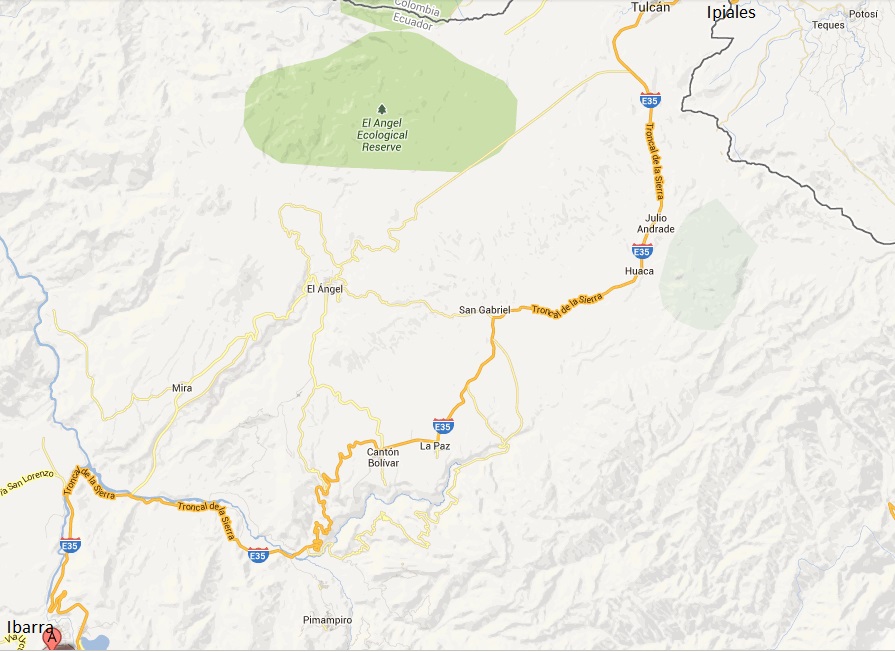
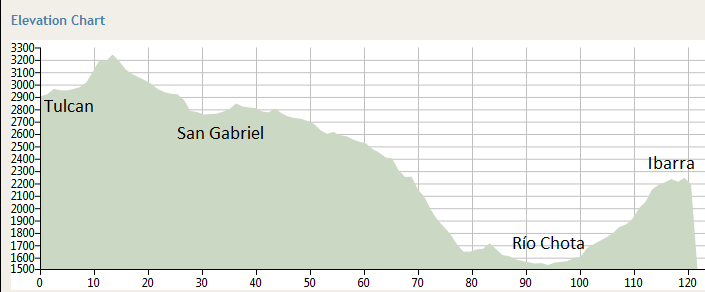
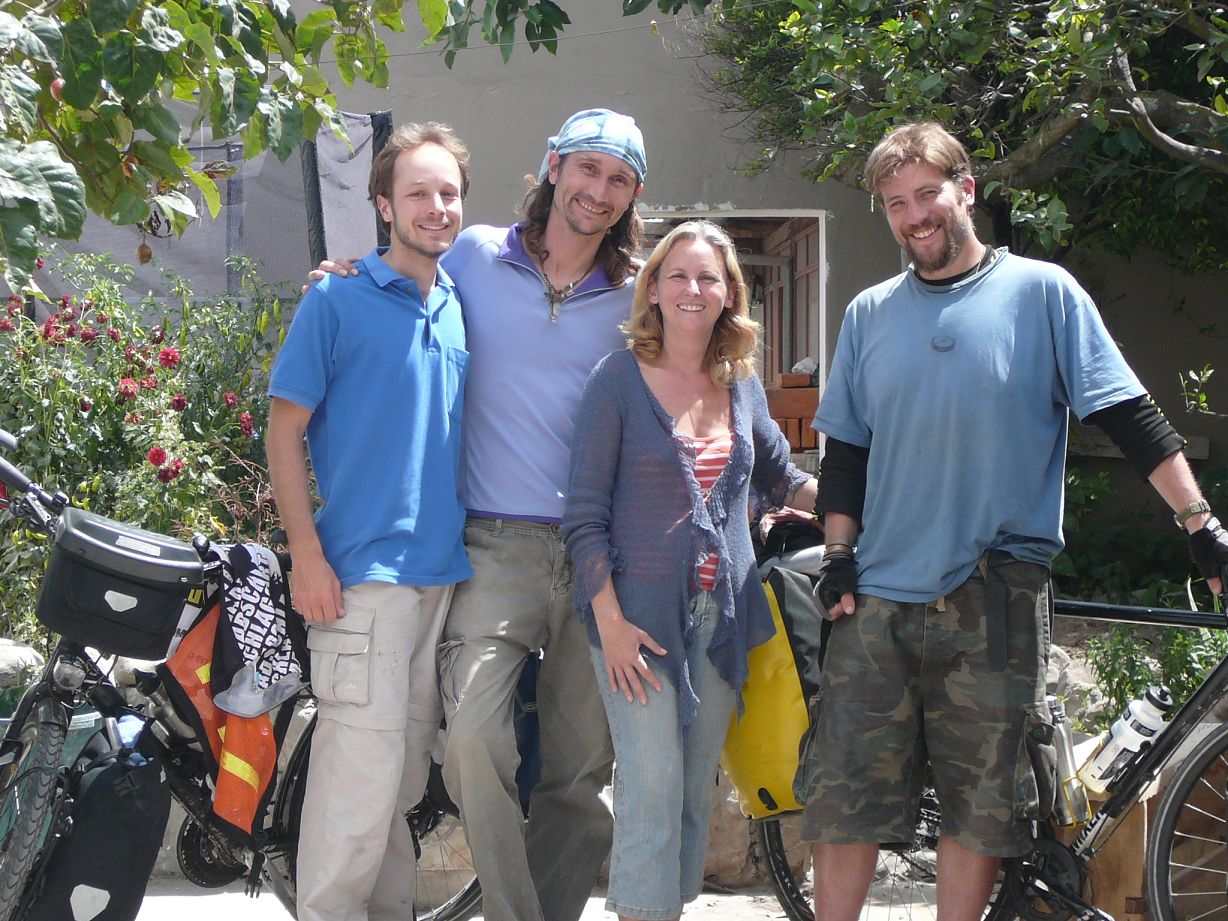
Colombia: Farewell
Tomorrow, I will cross the frontier to Ecuador, starting a new chapter of my journey.
I take the occasion to thank all those who made my stay in Colombia such a wonderful time, one of the luckiest periods in my life.
Some of them you may find in the category „Encuentros“.
And I like to thank those many roadmen who, constructing the roads in the dust, working under the burning sun, painting the medial strip, cleaning the side lanes, take care for the perfect state of the Colombian roads.
I cycled in this marvellous country for 1350km, climbing 17012 altitude meters.
And I feel that my story here did not yet come to its end.
Pasto – Ipiales: crossing the valley of Río Guáitara
The impression that people in this region are more introverted found evidence when I cycled from Pasto to Ipiales, the transit town next to the frontier to Ecuador: when I greeted they mostly just stared at me like an alien without answering or smiling. But this was only the beginning of a great day: climbing up by almost 700m to a pass at 3200m offered a splendid view on the montains around, each parcelled with cultivated fields in different colours. Then came a stretched out and perfect descent to the valley of Río Guáitara at about 1700m where I stopped at a fruit stand to refresh with some delicious Guayabas, grown at masses in this area. It became an extended rest of about 1,5 hours when the whole family gathered to ask for my experiences during the journey and to hear about my homeland far away. I continued with new energy thanks to this lovely encounter. Just behind the next curve, a motorbiker, after a risky overtaking maneuver, lost control of his bike, hurtled and laid on the ground five meters from my feet. He (and me as well!) had more luck than judgement: he seemed to be a bit dizzy but ok.
A few kilometers later, when climbing up to Ipiales, I met for the first time another travelling cyclist: the Panamericanista Andi, a crazy guy from Scotland traversing the country coming from Venezuela and now heading for the same direction. We continued together.
In a small town on the way, we heard Andinean music en vivo and stopped amid the festivity on the church square to admire the traditional suits and to have a dram of aguardiente. It was the midsummer fiesta for the god of the sun, Inti Rajmi. In the sunset we reached Ipiales: three apparently worried policemen accompanied us kindly on the search of a hostel. After 87km and 1835 altitude meters, I felt sufficiently tired.
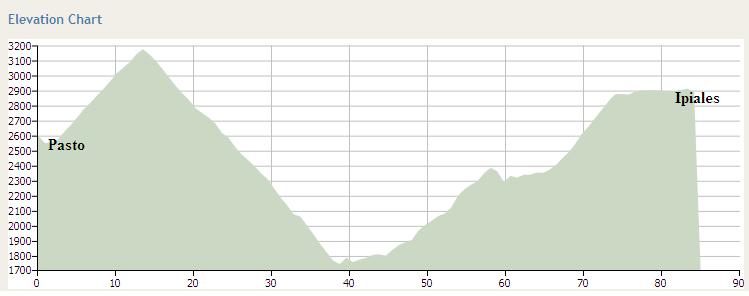
The famous V-shape
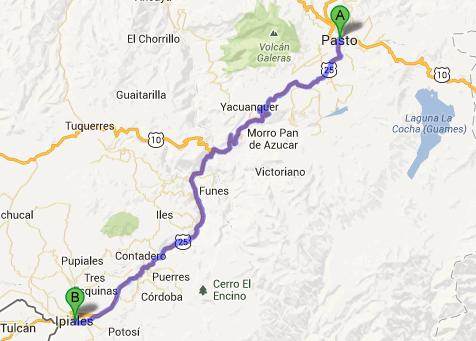
Pasto
After a sweet time in Morpheus arms I went for a late and (due to the delicate state of my stomach) light breakfast: from the table nearby the familiar sound of the southern german accent. After more than a month a welcome occasion to speak german! So I joined Andreas and Yvonne, who had worked for two months as school teacher in Popayan, for a day on the Laguna de Cocha. We enjoyed the refreshing air of the lake and the rich fauna on the small island.
Pasto itself is a lively city in the middle of the mountains and just in the neighbourhood of an active volcano who time and again spits his dust over the gray streets. The residents are more introverted than in the other parts of Colombia and seem rather reserved to strangers on first sight. But this shell only covers a kind and cordial hospitality: for dinner we were generously invited by Adel, my seatmate during the flight, eager to learn and share between the cultures.
Just when I wanted to leave the next day, I ran into a severe problem with the screws of my shoes which I could not turn due to their rotten thread. Luis from my comfortable hostel solved it by manually carving a suitable hexagon key: muchas gracias por todo!

Minca
The nature in Minca was balm for our battered bodies. After a relaxed breakfast on our patio over the rich garden we strived through the little village and undertook in the afternoon an easy walk to Pozo Azul, a natural pool below a cascade in the nearby river: what a refreshing bath! The day ended with a private lesson for me of the dance Reggaeton.
We had to return to Santa Marta to wrap the bicycle: an undertaking much more complicated than ever thought of: never touch a perfectly working machine! Due to my excitation, I would not have completed this task without the patient help of Estella and the owner of Casa Familar, respectively, to be honest, I watched them cutting the carton and sealing it.
The next day was the painful farewell leave on the airport: Estella went back to Pereira and I flew over the whole country to Pasto in the south to continue my journey traversing the frontier to Ecuador. When would we ever see us again? It is one of the most existential moments when two biographies intertwined for an intense time separate leaping in the dark, it is the pain a traveller must learn to stand.
Paradise Lost: The National Park Tayrona
My bike well stored with the friendly owner of Casa Familiar, we took a bus to the near national park Tayrona. Yes, it was very hot and the mochila was heavy, packed to survive three days in the wilderness. But we were enraptured by the beautiful scenery when, after three hours of walk in the jungle, we reached the sandy beaches of the coastline in the sunset. It was a picture like sprung from a catalogue of the untapped Carribean, a dreamy vision for the longing soul.
In the falling darkness the steady murmur of the ocean mixed with the rich sounds of the jungle, the crying of micos, little monkeys, the buzz of crickets, the croaking of frogs and the call of sleepy birds. The concierto followed us into our dreams in a light tent on the camping site Don Pedro.
After a hearty breakfast at Panadería Vere (the best bread I’ve tasted since travelling), we discovered the beaches up to Cabo San Juan with two mates we’ve met on the way, with Lazaro and Elisabeth, un día de descanso in preparation of the tough walk we planned for the following day. For supper, Estella prepared delicious Pasta on a log-fire.
Passing Cabo again, we left the sea to traverse the jungle on an old indigenous track mounting up to Pueblito, today few ruins on a green glade which about 800 years ago counted a population of 3000 people. It was a nice stone-paved path through dense thicket, crossing at times little streams and climbing small rocks. In the humid tropical heat our sweating soonly spoilt up our water reserves which we refilled hesitantly in a river.
After about 8 hours we got to Calabazo along the carretera and stopped a bus to Santa Marta. The relaxation was short: in a good distance from our destination the road was blocked by violent manifestations in a suburb which was cut from electricity supply for more than a month. The only way to proceed was again by feet and after passing the blocked bridge on the back of two moto-taxis. Due to these unforeseen complications we missed in Santa Marta the last bus to Minca, a village in the milder climate of 630 meters above sea level. Thanks to Estella’s charming negociation skills, we finally got a cab ride and arrived -after one more walk up the hill of course- at about 8 p.m. a calm and lovely cabaña of a finca on fresh green meadows.

